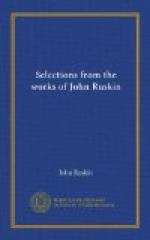[138] See note 1, p. 129.
[139] Childe Harold, 4. 1.
[140] Marino Faliero, 3. 1. 22 ff.
[141] Dandolo [c. 1108-1205] and Foscari
[1372-1457] were among the
most famous of Venetian Doges.
[142] In the battle of Custozza, 1848,
the Austrians defeated the
Piedmontese.
ST. MARK’S
VOLUME II, CHAPTER 4
“And so Barnabas took Mark, and sailed unto Cyprus.” If as the shores of Asia lessened upon his sight, the spirit of prophecy had entered into the heart of the weak disciple who had turned back when his hand was on the plough, and who had been judged, by the chiefest of Christ’s captains, unworthy thenceforward to go forth with him to the work,[143] how wonderful would he have thought it, that by the lion symbol in future ages he was to be represented among men! how woful, that the war-cry of his name should so often reanimate the rage of the soldier, on those very plains where he himself had failed in the courage of the Christian, and so often dye with fruitless blood that very Cypriot Sea, over whose waves, in repentance and shame, he was following the Son of Consolation!
That the Venetians possessed themselves of his body in the ninth century, there appears no sufficient reason to doubt, nor that it was principally in consequence of their having done so, that they chose him for their patron saint. There exists, however, a tradition that before he went into Egypt he had founded the church at Aquileia, and was thus in some sort the first bishop of the Venetian isles and people. I believe that this tradition stands on nearly as good grounds as that of St. Peter having been the first bishop of Rome[144]; but, as usual, it is enriched by various later additions and embellishments, much resembling the stories told respecting the church of Murano. Thus we find it recorded by the Santo Padre who compiled the Vife de’ Santi spettanti alle Chiese di Venezia,[145] that “St. Mark having seen the people of Aquileia well grounded in religion, and being called to Rome by St. Peter, before setting off took with him the holy bishop Hermagoras, and went in a small boat to the marshes of Venice. There were at that period some houses built upon a certain high bank called Rialto, and the boat being driven by the wind was anchored in a marshy place, when St. Mark, snatched into ecstasy, heard the voice of an angel saying to him: ‘Peace be to thee, Mark; here shall thy body rest.’” The angel goes on to foretell the building of “una stupenda, ne piu veduta Citta"[146]; but the fable is hardly ingenious enough to deserve farther relation.




